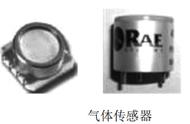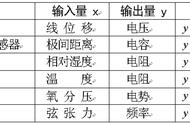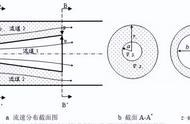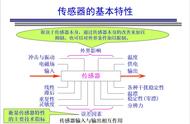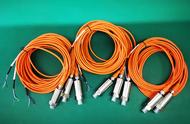《传感器与检测技术(第3版)》习题参考答案(20200830版)
2.1 什么是传感器的静态特性?描述传感器静态特性的主要指标有哪些?
答:传感器的静特性是它在稳态信号作用下的输入一输出关系。 静态特征所描述的传感器的输入、输出关系中不含时间变量。 其主要指标有线性度、灵敏度、分辨率、迟滞、重复性和漂移。
2.2传感器输入输出特性的线性化有什么意义?如何实现其线性化?
答:传感器的理想输入一输出特性应是线性化的,有助于简化传感器的理论分析、数据处理、制作标定和测试。 若传感器的非线性项的次方不高,在输入量变化范围不大的条件下,可以用切线或割线拟合、过零旋转拟合、端点平移拟合等来近似的代表实际曲线的 一段,但多数情况下是用最小二乘法求出拟合直线。
2.3什么是传感署的动态特性?如何分析传感器的动态特性?
答:传感器的动态特征是指传感器对动态激励(输入)的响应(输出)特征,即其输出对随时间变化的输入量的响应特性。 传感器的动态特性可以从时域和频域两个方面分别采用瞬态响应法和频率响应法来分析。
2.4 描述传感器动态特性的主要指标有哪些?
答:传感器动态特征的主要指标有时间常数、延迟时间、上升时间、峰值时间、响应时间、超调量
2.5试解释线性时不变系统的壘加性和频率保持特性的含义及其意义。
答: ①叠加性
含义:当一个系统有N个激励同时作用时,它的响应等于N个激励单独左右的响应之和。
即各个输入所引起的输出互不影响。
意义:当检测系统的输入信号是由多个信号叠加而成的复杂信号时,根据叠加性可以把复杂信号的作用看成若干型号的单独作用之和,从而简化问题。
②频率保持特性
含义:当线性定常系统的输入为某一频率的简谱(正弦或余弦)信号x()=Xocos(ar)时,系统的稳态输出必定是与输入同频率的简谱信号,即x()= Y, cos(car 4),。 但幅值和初始相位可能发生变化。
意义:如果已知线性系统的输入频率,根据频率保持特性,可确定该系统输出信号中只有与输入同频率的成分可能是该信号引起的输出,其他频率成分的输出都是噪声干扰,可以采用 滤波技术,在很强的噪声干扰下,也能把有用信息提取出来。
《传成器与检测技术(第3版))习题参者签案(2020083版)
Reference Answers to Exercises of "Sensors and Detection Technology (3rd Edition)" (20200830 Edition)
2.1 What are the static characteristics of the sensor? What are the main indicators describing the static characteristics of the sensor?
Answer: The static characteristic of the sensor is its input-output relationship under the action of steady-state signal. The input and output relationship of the sensor described by the static characteristics does not contain time variables. Its main indicators are linearity, sensitivity, resolution, hysteresis, repeatability and drift.
2.2 What is the significance of the linearization of sensor input and output characteristics? How to achieve its linearization?
Answer: The ideal input-output characteristics of the sensor should be linearized, which helps to simplify the theoretical analysis, data processing, production calibration and testing of the sensor. If the power of the nonlinear term of the sensor is not high, under the condition that the input variable range is not large, tangent or secant fitting, zero-crossing rotation fitting, end-point translation fitting, etc. can be used to approximate the actual curve. One paragraph, but in most cases, the least square method is used to find the fitted straight line.
2.3 What is the dynamic characteristics of the sensor? How to analyze the dynamic characteristics of the sensor?
Answer: The dynamic characteristic of the sensor refers to the response (output) characteristic of the sensor to dynamic excitation (input), that is, the response characteristic of its output to the input quantity that changes with time. The dynamic characteristics of the sensor can be analyzed by the transient response method and the frequency response method from the time domain and frequency domain respectively.
2.4 What are the main indicators describing the dynamic characteristics of the sensor?
Answer: The main indicators of sensor dynamic characteristics are time constant, delay time, rise time, peak time, response time, overshoot
2.5 Try to explain the meaning and significance of the additive and frequency retention characteristics of the linear time-invariant system.
Answer: ①Additionality
Meaning: When a system has N stimuli acting at the same time, its response is equal to the sum of the responses of the N stimuli.
That is, the output caused by each input does not affect each other.
Significance: When the input signal of the detection system is a complex signal superimposed by multiple signals, the function of the complex signal can be regarded as the sum of the individual functions of several models according to the superposition, thus simplifying the problem.
②Frequency retention characteristics
Meaning: When the input of a linear time-invariant system is a numbered spectrum (sine or cosine) signal of a certain frequency x()=Xocos(ar), the steady-state output of the system must be a numbered spectrum signal with the same frequency as the input, that is, x()= Y, cos(car 4),. However, the amplitude and initial phase may change.
Significance: If the input frequency of the linear system is known, according to the frequency retention characteristics, it can be determined that only the components of the system output signal with the same frequency as the input may be the output caused by the signal, and the output of other frequency components are noise interference, which can be used Filtering technology can also extract useful information under strong noise interference.
"Translator and Detection Technology (3rd Edition)) Exercise Participants Signing (2020083 Edition)
